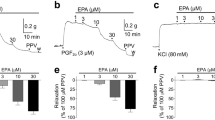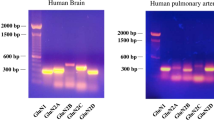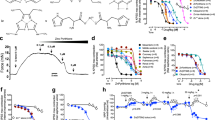Abstract
In arteries, muscarinic agonists such as acetylcholine release an unidentified, endothelium-derived hyperpolarizing factor (EDHF) which is neither prostacyclin nor nitric oxide1,2,3. Here we show that EDHF-induced hyperpolarization of smooth muscle and relaxation of small resistance arteries are inhibited by ouabain plus Ba2+; ouabain is a blocker of Na+/K+ ATPase4 and Ba2+ blocks inwardly rectifying K+ channels5. Small increases in the amount of extracellular K+ mimic these effects of EDHF in a ouabain- and Ba2+-sensitive, but endothelium-independent, manner. Acetylcholine hyperpolarizes endothelial cells and increases the K+ concentration in the myoendothelial space; these effects are abolished by charbdotoxin plus apamin. Hyperpolarization of smooth muscle by EDHF is also abolished by this toxin combination, but these toxins do not affect the hyperpolarizaiton of smooth muscle by added K+. These data show that EDHF is K+ that effluxes through charybdotoxin- and apamin-sensitive K+ channels on endothelial cells. The resulting increase in myoendothelial K+ concentration hyperpolarizes and relaxes adjacent smooth-muscle cells by activating Ba2+-sensitive K+ channels and Na+/K+ ATPase. These results show that fluctuations in K+ levels originating within the blood vessel itself are important in regulating mammalian blood pressure and flow.
This is a preview of subscription content, access via your institution
Access options
Subscribe to this journal
Receive 51 print issues and online access
$199.00 per year
only $3.90 per issue
Buy this article
- Purchase on Springer Link
- Instant access to full article PDF
Prices may be subject to local taxes which are calculated during checkout




Similar content being viewed by others
References
Bolton, T. B., Lang, R. J. & Takewaki, T. Mechanism of action of noradrenaline and carbachol on smooth muscle of guinea-pig anterior mesenteric artery. J. Physiol. 351, 549–572 (1984).
Garland, C. J., Plane, F., Kemp, BK. & Cocks, T. A. Endothelium-dependent hyperpolarization: a role in the control of vascular tone. Trends Pharmacol. Sci. 16, 23–30 (1995).
Edwards, G. & Weston, A. H. Endothelium-derived hyperpolarizing factor—a critical appraisal. Prog. Drug Res. 50, 107–133 (1998).
Félétou, M. & Vanhoutte, P. M. Endothelium-derived hyperpolarization of canine coronary smooth muscle. Br. J. Pharmacol. 93, 515–524 (1988).
Edwards, F. R. & Hirst, G. D. S. Inward rectification in submucosal arterioles of guinea-pig ileum. J. Physiol. 404, 437–454 (1988).
Waldron, G. J. & Garland, C. J. Effect of potassium channel blockers on L-NAME insensitive relaxations in rat small mesenteric artery. Can. J. Physiol. Pharmacol. 72 (Suppl. 1), 11 (1994).
Zygmunt, P. M. & Högestätt, E. D. Role of potassium channels in endothelium-dependent relaxation resistant to nitroarginine in the rat hepatic artery. Br. J. Pharmacol. 117, 1600–1606 (1996).
Marchenko, S. M. & Sage, S. O. Calcium-activated potassium channels in the endothelium of intact rat aorta. J. Physiol. 492, 53–60 (1996).
Hoeffner, U., Félétou, M., Flavahan, N. A. & Vanhoutte, P. M. Canine arteries release two different endothelium-derived relaxing factors. Am. J. Physiol. 257, H330–H333 (1989).
Gordon, J. L. & Martin, W. Endothelium-dependent relaxation of the pig aorta: relationship to stimulation of 86Rb efflux from isolated endothelial cells. Br. J. Pharmacol. 79, 531–541 (1983).
Knot, H. J., Zimmermann, P. A. & Nelson, M. T. Extracellular K+-induced hyperpolarizations and dilations of rat coronary and cerebral arteries involve inward rectifier channels. J. Physiol. 492, 419–430 (1996).
Newby, A. C. & Henderson, A. H. Stimulus-secretion coupling in vascular endothelial cells. Annu. Rev. Physiol. 52, 661–674 (1990).
Garcia, M. L., Knaus, H. G., Munujos, P., Slaughter, R. S. & Kaczorowski, G. J. Charybdotoxin and its effects on potassium channels. Am. J. Physiol. 38, C1–C10 (1995).
Prior, H. M., Webster, N., Quinn, K., Beech, D. J. & Yates, M. S. K+-induced dilation of a small renal artery: no role for inward rectifier K+ channels. Cardiovasc. Res. 37, 780–790 (1998).
Wellman, G. C., Quayle, J. M. & Standen, N. B. Evidence against the association of the sulphonylurea receptor with endogenous Kir family members other than KATPin coronary vascular smooth muscle. Pflugers Arch. 432, 355–357 (1996).
Feelisch, M. & Noack, E. Nitric oxide (NO) formation from nitrovasodilators occurs independently of hemoglobin or non-heme iron. Eur. J. Pharmacol. 142, 465–469 (1987).
Edwards, G. & Weston, A. H. Recent advances in potassium channel modulation. Prog. Drug Res. 49, 93–121 (1997).
Garland, C. J. & McPherson, G. A. Evidence that nitric oxide does not mediate the hyperpolarization and relaxation of acetylcholine in the rat small mesenteric artery. Br. J. Pharmacol. 105, 429–435 (1992).
McCarron, J. G. & Halpern, W. Potassium dilates rat cerebral arteries by two independent mechanisms. Am. J. Physiol. 259, H902–H908 (1990).
Chaytor, A. T., Evans, W. H. & Griffith, T. M. Central role of heterocellular gap junctional communication in endothelium-dependent relaxations of rabbit arteries. J. Physiol. 508, 561–573 (1998).
Dora, K. A., Doyle, M. P. & Duling, B. R. Elevation of intracellular calcium in smooth muscle causes endothelial cell generation of NO in arterioles. Proc. Natl Acad. Sci. USA 94, 6529–6534 (1997).
Campbell, W. B., Gebremedhin, D., Pratt, P. F. & Harder, D. R. Identification of epoxyeicosatrienoic acids as endothelium-derived hyperpolarizing factors. Circ. Res. 78, 415–423 (1996).
Popp, R., Bauersachs, J., Hecker, M., Fleming, I. & Busse, R. Atransferable, β-naphthoflavone-inducible, hyperpolarizing factor is synthesized by native and cultured porcine coronary endothelial cells. J. Physiol. 497, 699–709 (1996).
Chataigneau, T., Félétou, M., Duhault, J. & Vanhoutte, P. M. Epoxyeicosatrienoic acids, potassium channel blockers and endothelium-dependent hyperpolarization in the guinea-pig carotid artery. Br. J. Pharmacol. 123, 574–580 (1998).
Bolotina, V., Najibi, S., Palacino, J. J., Pagano, P. J. & Cohen, R. A. Nitric oxide directly activates calcium-dependent potassium channels in vascular smooth muscle. Nature 368, 850–853 (1994).
Kuschinsky, W., Wahl, M., Bosse, O. & Thurau, K. Perivascular potassium and pH as determinants of local pial arterial diameter in cats. Circ. Res. 31, 240–247 (1972).
Buenger, R., Haddy, F. J., Querengasser, A. & Eckehart, G. Studies on potassium induced coronary dilation in the isolated guinea pig heart. Pflugers Arch. 363, 27–31 (1976).
Paterson, D. J. Role of potassium in the regulation of systemic physiological function during exercise. Acta Physiol. Scand. 156, 287–294 (1996).
Zygmunt, P. et al. Studies on the effects of anandamide in rat hepatic artery. Br. J. Pharmacol. 122, 1679–1686 (1997).
Danker, T., Gaßner, B., Oberleithner, H. & Schwab, A. Extracellular detection of K+ release during migration of transformed Madin-Darby canine kidney cells. Pflugers Arch. 433, 71–76 (1996).
Acknowledgements
We thank D. Beech, J.-L. Bény, M. Félétou, S. Greenwood, N. Standen, A. Wareham and A. Schwab for advice. This work was supported by the British Heart Foundation, the MRC and the Wellcome Trust.
Author information
Authors and Affiliations
Corresponding author
Rights and permissions
About this article
Cite this article
Edwards, G., Dora, K., Gardener, M. et al. K+ is an endothelium-derived hyperpolarizing factor in rat arteries. Nature 396, 269–272 (1998). https://doi.org/10.1038/24388
Received:
Accepted:
Issue Date:
DOI: https://doi.org/10.1038/24388
This article is cited by
-
Signaling pathways in vascular function and hypertension: molecular mechanisms and therapeutic interventions
Signal Transduction and Targeted Therapy (2023)
-
Pathophysiological adaptations of resistance arteries in rat offspring exposed in utero to maternal obesity is associated with sex-specific epigenetic alterations
International Journal of Obesity (2021)
-
Effects of β1-adrenergic receptor blockade on the cerebral microcirculation in the normal state and during global brain ischemia/reperfusion injury in rabbits
BMC Pharmacology and Toxicology (2020)
-
Update on the role of endothelial cells in trauma
European Journal of Trauma and Emergency Surgery (2018)
Comments
By submitting a comment you agree to abide by our Terms and Community Guidelines. If you find something abusive or that does not comply with our terms or guidelines please flag it as inappropriate.



